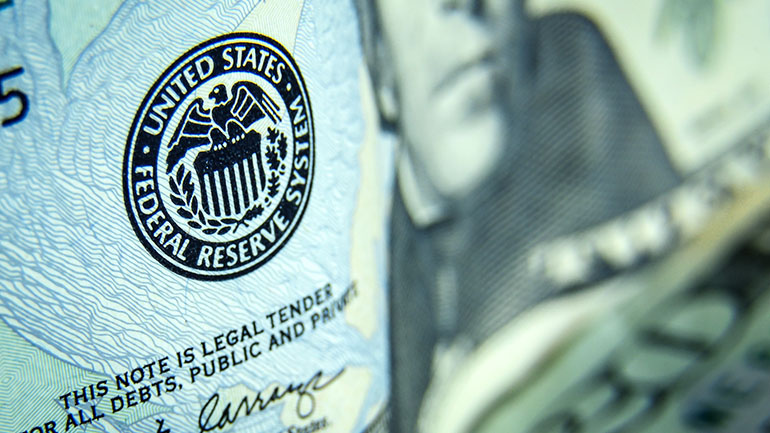Analyzing the Fed exit: What are the far-reaching impacts?
By: Priya Misra and Oscar Muñoz
March 10, 2022
-
4 minutes 30 seconds
Immediately following the initial financial consequences of the COVID-19 pandemic, the Federal Reserve took significant steps to ease economic pressures, such as cutting interest rates to zero and purchasing Treasuries and Mortgage Backed Securities (MBS). Now, two years later and almost to the anniversary of the onset of the pandemic, the Fed is signaling that they are immediately going to unwind both the interest rate easing as well as its balance sheet policy.
Since the start of 2022, the market increased their pricing for rate hikes from 75 basis points to 150 basis points. Ten-year treasuries have risen by 45 basis points and MBS spreads have widened by over 35 basis points. Meanwhile, the S&P 500 has fallen by 10% and NASDAQ by more than 15%. The Fed exit and the recent jitters stemming from the Russia-Ukraine geopolitical conflict have had a significant effect across asset classes.
What is the outlook for the global economy?
The economy has been growing due to massive stimulus packages and monetary returns and the Fed is ready to begin removing some of its stimulus. This will likely commence with a 25 basis points increase in the Fed funds rate this month, as was telegraphed by the Fed Chair Powell before Congress.
These actions look to mark the start of the tightening cycle. We look for the Fed to continue hiking at each meeting through to November 2022 for a total of 150 basis points of policy rate increases.
The start of the tightening cycle
Markets have been increasingly pricing in more and more tightening, including after the last Fed meeting. The Fed kept emphasizing how the economy appears much stronger now than it did with the last tightening cycle between 2015 and 2018. The implication seemed to be that the Fed would need to tighten more rapidly than they did last time.
But there are other important considerations besides how strong the economy looks right now. One consideration is that fiscal policy will be tightened much more quickly in the year ahead than it did during the last cycle. We expect that tightening to contribute to slowing inflation as well as growth, particularly for the second half of 2022. A second consideration is the outcome of the ongoing Russia-Ukraine conflict, which has added to uncertainties for the forecast horizon.
Shrinking the Fed balance sheet
However, we don't think this will be enough to reduce the pressure on the Fed to continue removing accommodation. We expect GDP growth to slow to around 2.5% this year, from 5.5% last year. We also expect inflation to slow significantly as well. We look for CPI to decrease from 7% year over year to 3.5% by the end of the year.
A second key consideration is that the Fed will be shrinking its balance sheet much earlier. This quantitative tightening (QT) will, to some extent, substitute for rate hikes. We expect QT to be announced at the May meeting and be phased in over three months. The result would likely be Fed assets shrinking by up to US$90 billion per month when fully phased in. Last time, QT only began two years after the first rate hike, took over 12 months to phase in, and was capped at US$50 billion per month. This is likely to be a more aggressive tightening cycle compared with the last one.
Should the Fed hike rates?
One option that remains available to the Fed is hiking rates more quickly than 25 basis points per meeting, potentially opting for a 50 basis point move. This would send a strong message to the market that the Fed is serious about clamping down on inflation. However, we think the Fed has sufficient options and policy tools to send a strong tightening signal without resorting to intermeeting or 50 basis point rate hikes. While this was previously our base-case scenario, we now think this could be an option later in the year if inflation does not show signs of abating. The Russia-Ukraine conflict is likely to argue for a less aggressive start to hikes from the Fed.
In terms of the balance sheet, we do not expect active asset sales from the Fed. Balance sheet runoff is likely to be a passive process wherein the Fed does not reinvest maturing securities on their balance sheet. This will gradually and organically tighten policy toward more normal levels and we expect the Fed's balance sheet to reach a more "normal" level of around 22% of GDP by the end of 2024 or early 2025 (from 37% today).
The rates market has been particularly volatile as it attempts to reconcile two conflicting forces – the strong domestic fundamentals and enormous geopolitical uncertainty. The first condition requires the Fed to raise rates significantly and tighten policy, which should push 10 year Treasury yields to 2.5% by the end of 2022 and 2.75% by the end of 2023. In addition, Fed balance sheet runoff is likely to pressure long-term interest rates higher as the US Treasury will need to raise additional funds to repay maturing securities held by the Fed. This should put upward pressure on interest rates and could help steepen the yield curve later in the cycle. All in all, we have a Fed that is telling us they are going to be nimble, growth that is inherently hard to forecast, and now enormous geopolitical uncertainty.
The views or opinions expressed herein represent the personal views of the speaker and do not necessarily reflect the views of TD Securities or its affiliates. This material is intended to provide commentary on economic, political or market conditions. Not Advice: The information contained in this material is for informational purposes only and is not intended to provide professional, investment or any other type of advice or recommendation, or to create a contractual or fiduciary relationship. Neither TD Securities (USA) LLC (“TD Securities USA”) nor any of its affiliates (collectively, “TD”) makes any representation or warranty, express or implied, regarding the accuracy, reliability, completeness, appropriateness or sufficiency for any purpose of any information included in this material. Certain information may have been provided by third-party sources and, while believed to be reliable, has not been independently verified by TD, and its accuracy or completeness cannot be guaranteed. Not Securities or Derivatives Research: This material has not been produced, reviewed or approved by TD’s securities or derivatives research departments. The views of the author may differ from others at TD, including TD securities or derivatives research analysts. Not Independent: The views expressed in this material may not be independent of the interests of TD.
Priya Misra
Managing Director and Global Head of Rates Strategy, TD Securities
Priya Misra
Managing Director and Global Head of Rates Strategy, TD Securities
Priya Misra
Managing Director and Global Head of Rates Strategy, TD Securities
Priya is responsible for the macro calls on the U.S. and global interest rate markets and provides investment advice to clients. She represents TD at the Fed's Alternative Reference Rate Committee (ARRC) and is actively involved in the transition from LIBOR to SOFR. She publishes regular research on interest rates, discussing secular trends as well as trade ideas and manages a model portfolio of recommendations.
Oscar Muñoz
Vice President and U.S. Macro Strategist, TD Securities
Oscar Muñoz
Vice President and U.S. Macro Strategist, TD Securities
Oscar Muñoz
Vice President and U.S. Macro Strategist, TD Securities
Oscar provides research and analysis on the U.S. economy and financial markets for both internal and external clients. Prior to joining TD Securities in 2018, Oscar worked as a LatAm Economist in New York for four years.








